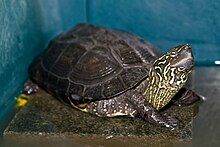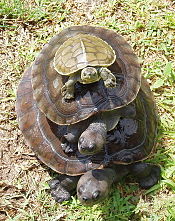Chinese pond turtle
| Chinese pond turtle | |
|---|---|

| |
| Scientific classification | |
| Kingdom: | |
| Phylum: | |
| Class: | |
| Order: | |
| Suborder: | |
| Superfamily: | |
| Family: | |
| Genus: | |
| Species: | M. reevesii
|
| Binomial name | |
| Mauremys reevesii[1] (Gray, 1831)[1]
| |
| Synonyms[3] | |
| |

The Chinese pond turtle, Reeves' turtle, or Chinese three-keeled pond turtle (Mauremys reevesii)[1] is a species of turtles in the family Geoemydidae (formerly called Bataguridae). It is found in China, Japan, Korea and Taiwan.[1][4] This species is semiaquatic, and basks in the sun on rocks or logs and can often be found leaving water to do so. They can usually be found in marshes, relatively shallow ponds, streams, and canals with muddy or sandy bottoms.
The Chinese three-keeled pond turtle (M. reevesii) is threatened by competition with released pet red-eared sliders (T. s. elegans), overhunting (its plastron is used in traditional Chinese medicine),[5][6] capturing for the pet trade and wild habitat destruction. The IUCN considers M. reevesii an endangered species.[4] This species, fortunately, breeds well in captivity.
Hybridization
This species is notorious for its ability to produce hybrids with other Geoemydidae, even species that are only distantly related. The supposed new species "Mauremys" pritchardi was based on a hybrid of unknown origin between a male of this species and a female yellow pond turtle (Mauremys mutica). Furthermore, it has hybridized with the Chinese stripe-necked turtle (Ocadia sinensis), female Malayan box turtles (Cuora amboinensis), a male four-eyed turtle (Sacalia quadriocellata), and the Japanese pond turtle (Mauremys japonica) in captivity.[7][8]
Any individuals that are available as pets therefore need to be kept separate from other members of the family.
Farming
M. reevesii is one of the species raised on China's turtle farms. According to a 1998 survey, 548 farms raised this turtle species in four provinces in China. The statistical data from different provinces were in different formats; however, two provinces reported 20,650 turtles living on 26 farms, with 5,000 animals reproduced annually; the other two provinces reported the total weight of their turtles, namely some 260 tons of these animals on 522 farms. Over the five-year period, 1990–1995, 13 traditional Chinese medicine factories consumed 430 tons of C. reevesii plastrons.[9]
Based on a more recent (2002) survey of 684 Chinese turtle farms (less than half of all 1,499 turtle farms that were registered at the time), researchers found that 2.8 million of turtles of this species (reported there as Chinemys reevesii) lived on these farms, with some 566,000 specimens sold by farmers every year. The total weight of the annual product was 320 tons, with the estimated value of over US$6 million, which makes the market value of a Chinese pond turtle equal to around $12—about twice as much that of the most common farmed species, Pelodiscus sinensis. Taking into account the registered farms that did not respond to the survey, as well as the unregistered producers, the total amounts must be considerably higher.[10]
Pet trade
Chinese pond turtles are also farmed for the pet trade. In captivity, they require similar care to red-eared sliders (T. s. elegans).
Conservation efforts
Timor-Leste
M. reevesii was not known to be present in Timor-Leste until during a conservation survey for other reptiles researchers confirmed its presence. M. reevesii is used in traditional Chinese medicine and kept as pets in Timor-Leste. The turtles are sold on the street in the more affluent districts of the capital. In order to ensure the viability of the population of M. reevesii in Timor-Leste researchers in uniforms informed individuals buying the turtles of their endangered species status to persuade the purchasers to donate the turtles for conservation efforts. Buyers of M. reevesii were not purchasing the turtles for food or medicine but were purchasing them as either pets or to release them for good luck (in relation to the Chinese New Year in this instance) and after convincing by the researchers would give the turtles to the researchers. In Timor-Leste the researchers found that volunteers in official clothing talking to people about the over exploited species is the best way to conserve the species.[11]
References
- ^ a b c d e Rhodin, Anders G.J.; van Dijk, Peter Paul; Inverson, John B.; Shaffer, H. Bradley (14 December 2010). "Turtles of the world, 2010 update: Annotated checklist of taxonomy, synonymy, distribution and conservation status". Chelonian Research Monographs. 5: 000.112. doi:10.3854/crm.5.000.checklist.v3.2010. Archived from the original (PDF) on 15 December 2010.
{{cite journal}}: CS1 maint: multiple names: authors list (link) - ^ Template:IUCN2014.3
- ^ Fritz Uwe; Peter Havaš (2007). "Checklist of Chelonians of the World". Vertebrate Zoology. 57 (2): 232–233. ISSN 1864-5755. Archived from the original (PDF) on 17 December 2010. Retrieved 29 May 2012.
- ^ a b ATTWG (2000)
- ^ da Nóbrega Alves, Rômulo Romeu; da Silva Vieira; Washington Luiz & Gomes Santana, Gindomar (2008): Reptiles used in traditional folk medicine: conservation implications. Biodiversity and Conservation 17(8): 2037–2049. doi:10.1007/s10531-007-9305-0 (HTML abstract, PDF first page)
- ^ Subhuti Dharmananda. "Endangered species issues affecting turtles and tortoises used in Chinese medicine".
- ^ * Parham, James Ford; Simison, W. Brian; Kozak, Kenneth H.; Feldman, Chris R. & Shi, Haitao (2001): New Chinese turtles: endangered or invalid? A reassessment of two species using mitochondrial DNA, allozyme electrophoresis and known-locality specimens. Animal Conservation 4(4): 357–367. PDF fulltext Erratum: Animal Conservation 5(1): 86 HTML abstract
- ^ Buskirk, James R.; Parham, James F. & Feldman, Chris R. (2005): On the hybridisation between two distantly related Asian turtles (Testudines: Sacalia × Mauremys). Salamandra 41: 21-26. PDF fulltext
- ^ GUO Yinfeng, ZOU Xueying, CHEN Yan, WANG Di & WANG Sung. "Sustainability of Wildlife Use in Traditional Chinese Medicine". 1998.; also quoted in: Subhuti Dharmananda. "Endangered species issues affecting turtles and tortoises used in Chinese medicine".
- ^ Shi, Haitao; Parham, James F; Fan, Zhiyong; Hong, Meiling; Yin, Feng (1 January 2008), "Evidence for the massive scale of turtle farming in China", Oryx, vol. 42, Cambridge University Press, pp. 147–150, doi:10.1017/S0030605308000562, retrieved 26 December 2009
- ^ Kaiser, Hinrich; Taylor, David; Heacox, Scott; Landry, Paul; Sanchez, Caitlin; Varela Ribeiro, Agivedo; Lemos de Araujo, Luis; Kathriner, Andrew; O'Shea, Mark (30 June 2013). "Conservation education in a post-conflict country five hematological case studies in Timor-Leste" (PDF). Salamandra. 49(2). ISSN 0036-3375. Retrieved 18 January 2016.
External links
- http://chinesische-dreikiel.npage.de/
- http://nlbif.eti.uva.nl/bis/turtles.php?menuentry=soorten&id=250
- http://www.arkive.org/chinese-pond-turtle/chinemys-reevesii/
- Chinemys reevesii, The Reptile
- http://www.biosch.hku.hk/ecology/hkreptiles/turtle/Mauremys_reevesii.html


